tow OLDSMOBILE SILHOUETTE 2003 Service Manual
[x] Cancel search | Manufacturer: OLDSMOBILE, Model Year: 2003, Model line: SILHOUETTE, Model: OLDSMOBILE SILHOUETTE 2003Pages: 466, PDF Size: 21.55 MB
Page 294 of 466
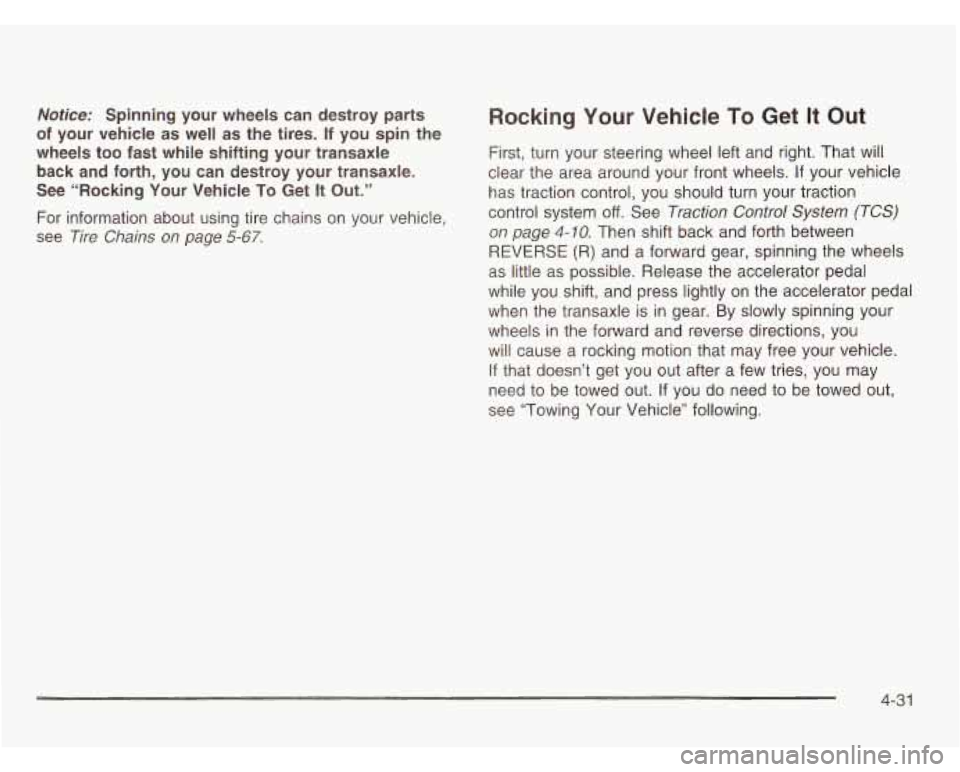
Notice: Spinning your wheels can destroy parts
of your vehicle as well
as the tires. If you spin the
wheels too fast while shifting your transaxle
back and forth, you can destroy your transaxle.
See “Rocking Your Vehicle
To Get It Out.”
For information about using tire chains on your vehicle,
see
Tire Chains on page 5-67.
Rocking Your Vehicle To Get It Out
First, turn your steering wheel left and right. That will
clear the area around your front wheels.
If your vehicle
has traction control, you should turn your traction
control system
off. See Traction Control System (TCS)
on page 4-10.
Then shift back and forth between
REVERSE (R) and a forward gear, spinning the wheels
as little as possible. Release the accelerator pedal
while you shift, and press lightly on the accelerator pedal
when the transaxle
is in gear. By slowly spinning your
wheels in the forward and reverse directions, you
will cause a rocking motion that may free your vehicle.
If that doesn’t get you out after a few tries, you may
need to be towed out. If you do need to be towed out,
see “Towing Your Vehicle” following.
4-31
Page 295 of 466

Towing
Towing Your Vehicle
Consult your dealer or a professional towing service
if you need to have your disabled vehicle towed.
See
Roadside Assistance Program on page 9-5.
If you want to tow your vehicle behind another vehicle
for recreational purposes (such as behind a motorhome),
see ”Recreational Vehicle Towing” following.
Recreational Vehicle Towing
Recreational vehicle towing means towing your vehicle
behind another vehicle
- such as behind a motorhome.
The two most common types of recreational vehicle
towing are known as “dinghy towing” (towing your vehicle
with all four wheels on the ground) and “dolly towing”
(towing your vehicle with two wheels on the ground and
two wheels up on a device know
as a “dolly”). With the proper preparation
and equipment, many
vehicles can be towed in these ways. See “Dinghy
Towing” and “Dolly Towing,” following.
Here are some important things to consider before you
do recreational vehicle towing:
What’s the towing capacity of the towing vehicle?
Be sure you read the tow vehicle manufacturer’s
recommendations.
How far will you tow? Some vehicles have
restrictions
on how far and how long they can tow.
Do you have the proper towing equipment?
See your dealer or trailering professional for
additional advice and equipment recommendations.
Is your vehicle ready to be towed? Just as you
would prepare your vehicle for a long trip, you’ll
want to make sure your vehicle is prepared
to be
towed. See
Before Leaving on a Long Trip on
page
4-23.
4-32
Page 296 of 466

Dinghy Towing Dolly Towing
Your vehicle was not designed to be towed with all of its
wheels on the ground.
If you have a two-wheel-drive
vehicle,
it can be towed with two of its wheels on
the ground. See “Dolly Towing” following.
If you have an
all-wheel-drive vehicle,
it cannot be towed with any of
its wheels on the ground. It can be towed with car carrier
equipment.
Notice: Towing an all-wheel-drive vehicle with all
four wheels on the ground, or even with only two of
its wheels on the ground, will damage drivetrain
components. Don’t tow an all-wheel-drive vehicle if
any
of its wheels will be on the ground. If
you have a two-wheel-drive vehicle, it can be towed
with two
of its wheels on the ground. To dolly tow
your vehicle, do the following:
1. Put the front wheels on a dolly.
2. Put the vehicle in PARK (P).
3. Set the parking brake and then remove the key.
4. Clamp the steering wheel in a straight-ahead
position with a clamping device designed for towing.
5. Release the parking brake.
If you have an all-wheel-drive vehicle, it cannot be
towed with any of its wheels on the ground. It can be
towed with car carrier equipment.
Notice: Towing an all-wheel-drive vehicle with all
four wheels on the ground,
or even with only two of
its wheels on the ground, will damage drivetrain
components. Don’t tow an all-wheel-drive vehicle if
any
of its wheels will be on the ground.
4-33
Page 299 of 466

Towiv a Trailer
=mm
If you don’t use the correct equipment and
drive properly, you can lose control when you
pull a trailer. For example, if the trailer is too
heavy, the brakes may not work well
-- or even
at all. You and your passengers could be
seriously injured. Pull a trailer only if you have
followed all the steps
in this section. Ask your
dealer for advice and information about towing
a trailer with your vehicle.
Notice: Pulling a trailer improperly can damage
your vehicle and result
in costly repairs not covered
by your warranty. To pull a trailer correctly, follow
the advice
in this part, and see your dealer for
important information about towing a trailer with
your vehicle. Additional rear axle maintenance
is required for a vehicle used to tow a trailer.
See “Scheduled Maintenance Services” in the Index. Your
vehicle can tow a trailer. To identify what the
vehicle trailering capacity
is for your vehicle, you should
read the information in “Weight of the Trailer” that
appears later in this section. But trailering is different
than just driving your vehicle by itself. Trailering means
changes in handling, durability and fuel economy.
Successful, safe trailering takes correct equipment
and
it has to be used properly.
That’s the reason for this section. In
it are many
time-tested, important trailering tips and safety rules.
Many
of these are important for your safety and that of
your passengers.
So please read this section carefully
before you pull a trailer.
Load-pulling components such as the engine, transaxle,
wheel assemblies and tires are forced to work harder
against the drag of the added weight. The engine
is required to operate at relatively higher speeds and
under greater loads, generating extra heat. What’s more,
the trailer adds considerably to wind resistance,
increasing the pulling requirements.
4-36
Page 300 of 466
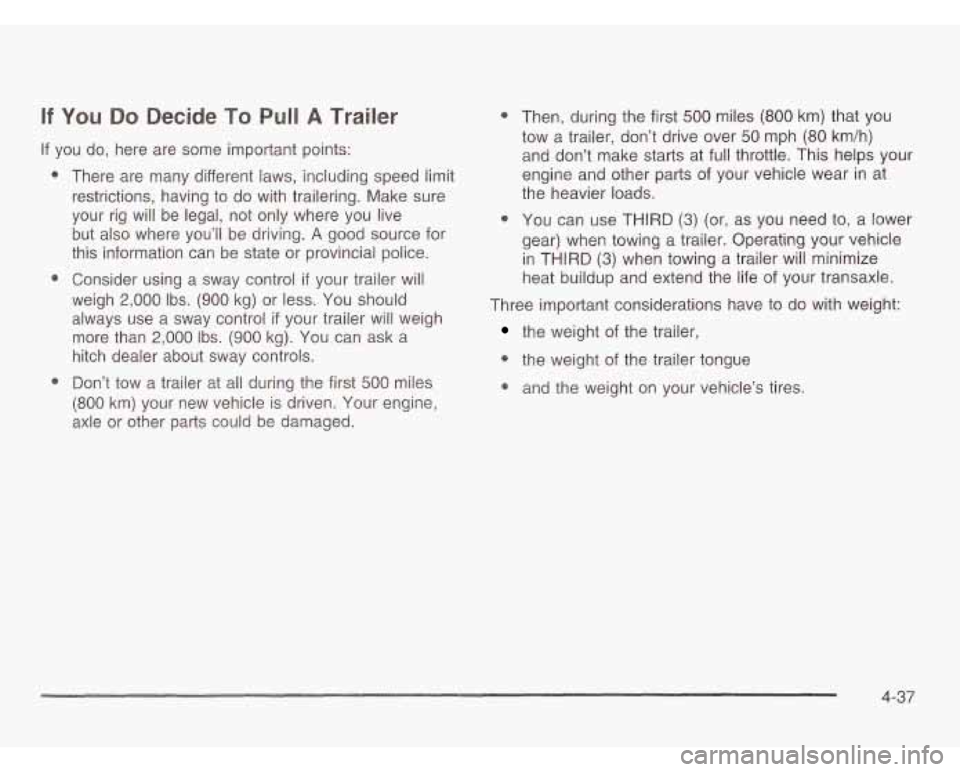
If You Do Decide To Pull A Trailer
If you do, here are some important points:
e
e
e
There are many different laws, including speed limit
restrictions, having
to do with trailering. Make sure
your rig will be legal, not only where you live
but also where you’ll be driving.
A good source for
this information can be state or provincial police.
Consider using a sway control
if your trailer will
weigh
2,000 Ibs. (900 kg) or less. You should
always use a sway control
if your trailer will weigh
more than
2,000 Ibs. (900 kg). You can ask a
hitch dealer about sway controls.
Don’t tow a trailer at
all during the first 500 miles
(800 km) your new vehicle is driven. Your engine,
axle or other parts could be damaged.
e
e Then, during the first 500 miles (800 km) that you
tow a trailer, don’t drive over
50 mph (80 km/h)
and don’t make starts at full throttle. This helps your
engine and other parts of your vehicle wear
in at
the heavier loads.
You can use THIRD
(3) (or, as you need to, a lower
gear) when towing
a trailer. Operating your vehicle
in THIRD
(3) when towing a trailer will minimize
heat buildup and extend the life
of your transaxle.
Three important considerations have to do with weight:
the weight of the trailer,
* the weight of the trailer tongue
and the weight on your vehicle’s tires.
4-37
Page 301 of 466

Weight of the Trailer
How heavy can a trailer safely be?
It should never weigh more than 1,400 Ibs. (630 kg) with
up to six occupants or more than
2,000 Ibs. (900 kg)
with up to two occupants.
If you have the optional trailer
towing package, your vehicle can tow up to 2,900 Ibs.
(1 300 kg) with up to six occupants or up to 3,500 Ibs.
(1 575 kg) with up to two occupants. But even that
can be too heavy.
It depends on how you plan to use your rig. For example,
speed, altitude, road grades, outside temperature and
how much your vehicle is used to pull a trailer are all
important. And, it can also depend on any special
equipment that you have on your vehicle.
You can ask your dealer for our trailering information or
advice, or you can write us at:
Oldsmobile Customer Assistance
P.O. Box 33171
Detroit,
MI 48232-51 71
In Canada, write to:
General Motors of Canada Limited
Customer Communication Centre, 163-005
1908 Colonel Sam Drive
Oshawa, Ontario L1H 8P7
Weight of the Trailer Tongue
The tongue load (A) of any trailer is an important weight
to measure because
it affects the total or gross weight
of your vehicle. The Gross Vehicle Weight (GVW)
includes the curb weight of the vehicle, any cargo you
may carry in it, and the people who will be riding in
the vehicle. And
if you will tow a trailer, you must add
the tongue load to the GVW because your vehicle will be
carrying that weight,
too. See Loading Your Vehicle
on page 4-34 for more information about your vehicle’s
maximum load capacity.
A B
4-38
Page 303 of 466
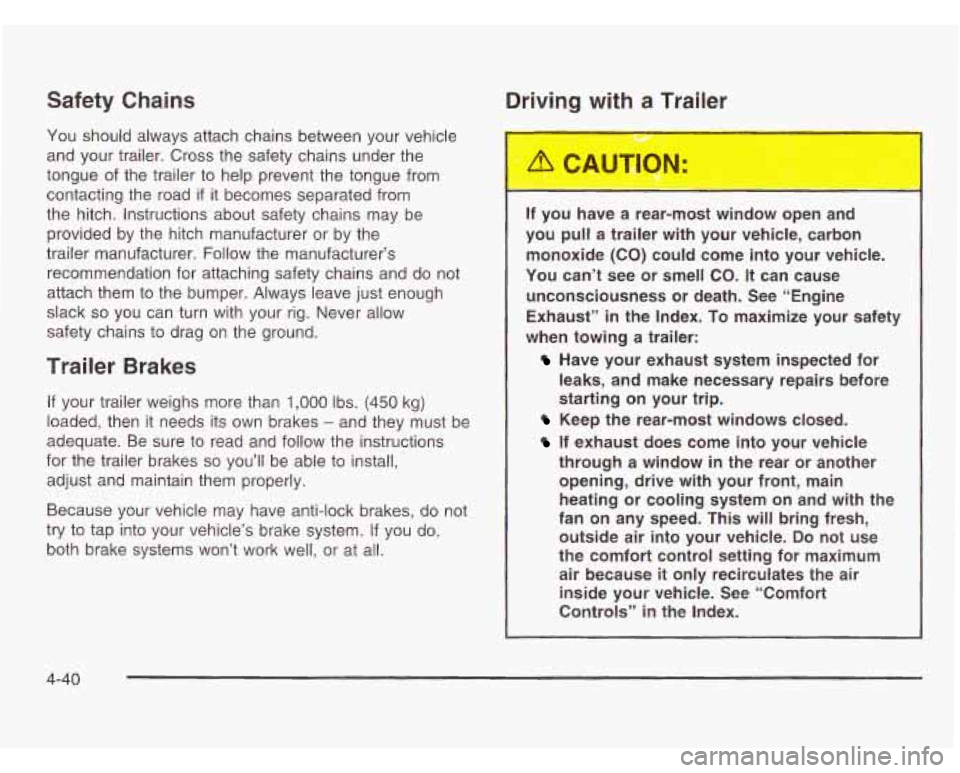
Safety Chains
You should always attach chains between your vehicle
and your trailer. Cross the safety chains under the
tongue
of the trailer to help prevent the tongue from
contacting the road
if it becomes separated from
the hitch. Instructions about safety chains may be
provided by the hitch manufacturer or by the
trailer manufacturer. Follow the manufacturer’s
recommendation for attaching safety chains and do not
attach them to the bumper. Always leave just enough
slack
so you can turn with your rig. Never allow
safety chains to drag on the ground.
Trailer Brakes
If your trailer weighs more than 1,000 Ibs. (450 kg)
loaded, then it needs its own brakes
- and they must be
adequate. Be sure to read and follow the instructions
for the trailer brakes
so you’ll be able to install,
adjust and maintain them properly.
Because your vehicle may have anti-lock brakes, do not
try to tap into your vehicle’s brake system.
If you do,
both brake systems won’t work well, or at all.
Driving with a Trailer
If you have a rear-most window open and
you pull a trailer with your vehicle, carbon monoxide (CO) could come into your vehicle.
You can’t see or smell
CO. It can cause
unconsciousness or death. See “Engine
Exhaust” in the Index.
To maximize your safety
when towing a trailer:
Have your exhaust system inspected for
leaks, and make necessary repairs before
starting on your trip.
Keep the rear-most windows closed.
If exhaust does come into your vehicle
through a window
in the rear or another
opening, drive with your front, main
heating or cooling system on and with the
fan on any speed. This will bring fresh,
outside air into your vehicle.
Do not use
the comfort control setting for maximum air because
it only recirculates the air
inside your vehicle. See ‘“Comfort
Controls” in
the Index.
4-40
Page 304 of 466
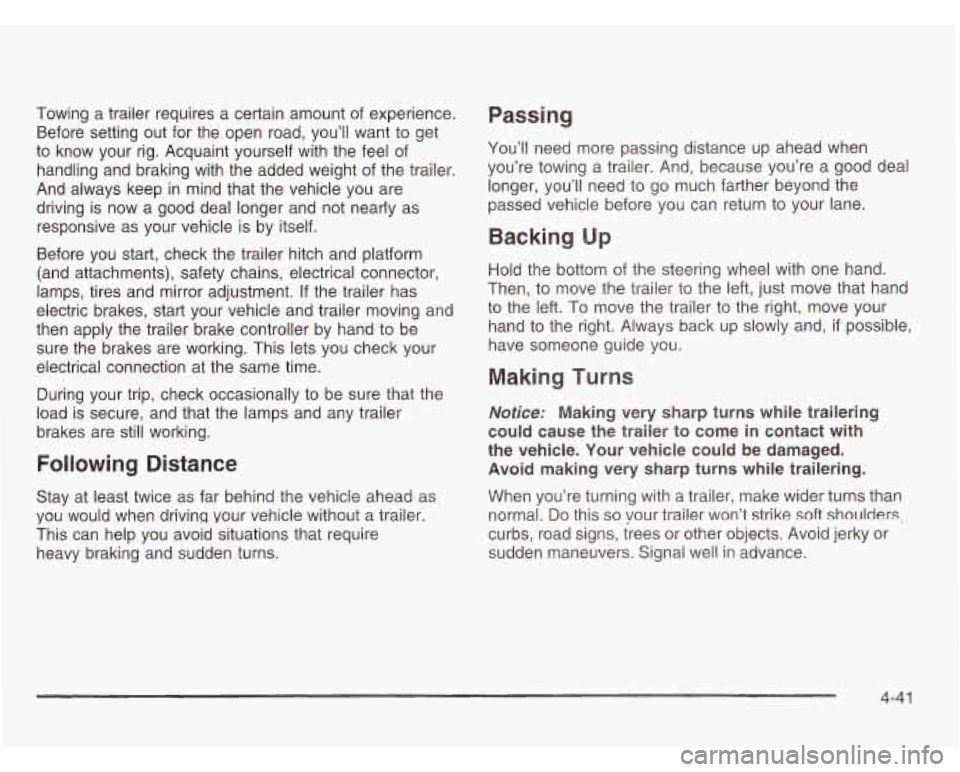
rowing a trailer requires a certain amount of experience.
Before setting out for the open road, you’ll want to get
to know your rig. Acquaint yourself with the feel of
handling and braking with the added weight of the trailer.
And always keep in mind that the vehicle you are
driving is now a good deal longer and not nearly as
responsive as your vehicle is by itself.
Before you start, check the trailer hitch and platform
(and attachments), safety chains, electrical connector,
lamps, tires and mirror adjustment. If the trailer has
electric brakes, start your vehicle and trailer moving and
then apply the trailer brake controller by hand to be
sure the brakes are working. This lets you check your
electrical connection at the same time.
During your trip, check occasionally to be sure that the
load is secure, and that the lamps and any trailer
brakes are still working.
Following Distance
Stay at least twice as far behind the vehicle ahead as
you would when driving your vehicle without a trailer.
This can help you avoid situations that require
heavy braking and sudden turns.
Passing
You’ll need more passing distance up ahead when
you’re towing a trailer. And, because you’re a good deal
longer, you’ll need to go much farther beyond the
passed vehicle before you can return to your lane.
Backing Up
Hold the bottom of the steering wheel with one hand.
Then, to move the trailer to the left, just move that hand
to the left. To move the trailer to the right, move your
hand to the right. Always back up slowly and,
if possible,
have someone guide you.
Making Turns
Notice: Making very sharp turns while trailering
could cause the trailer
to come in contact with
the vehicle. Your vehicle could be damaged.
Avoid making very sharp turns while trailering.
When you’re turning with a trailer, make wider turns than
normal.
Do this so your trailer won’t strike soft shoulders;
curbs, road signs, trees or other objects. Avoid jerky or
sudden maneuvers. Signal well
in advance.
4-41
Page 305 of 466
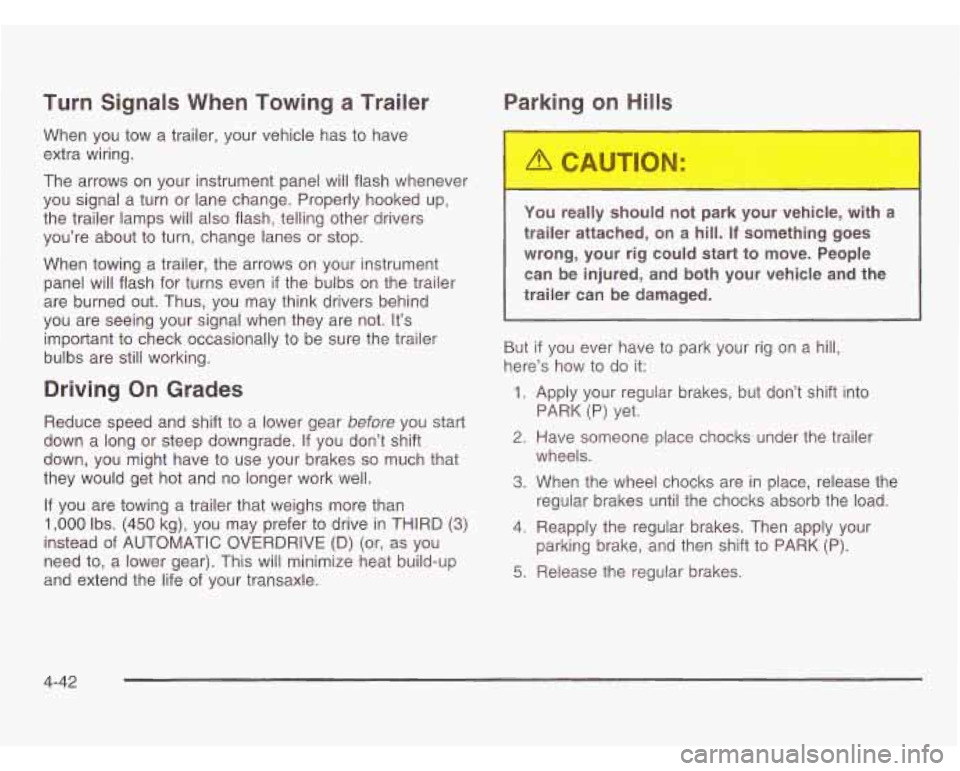
Turn Signals When Towing a Trailer
When you tow a trailer, your vehicle has to have
extra wiring.
The arrows on your instrument panel will flash whenever
you signal a turn or lane change. Properly hooked up,
the trailer lamps will also flash, telling other drivers
you’re about
to turn, change lanes or stop.
When towing a trailer, the arrows on your instrument
panel will flash for turns even
if the bulbs on the trailer
are burned out. Thus, you may think drivers behind
you are seeing your signal when they are not.
It’s
important to check occasionally to be sure the trailer
bulbs are still working.
Driving On Grades
Reduce speed and shift to a lower gear before you start
down a long or steep downgrade. If you don’t shift
down, you might have
to use your brakes so much that
they would get hot and no longer work well.
If you are towing a trailer that weighs more than
1,000 Ibs. (450 kg), you may prefer to drive in THIRD (3)
instead of AUTOMATIC OVERDRIVE (D) (or, as you
need
to, a lower gear). This will minimize heat build-up
and extend the life of your transaxle.
Parking on Hills
I
You really should not park your vehicle, u....~ a
trailer attached, on a hill. If something goes
wrong, your rig could start to move. People can be injured, and both your vehicle and the
trailer can be damaged.
But
if you ever have to park your rig on a hill,
here’s how to do it:
1. Apply your regular brakes, but don’t shift into
2, Have someone place chocks under the trailer
3. When the wheel chocks are in place, release the
PARK
(P) yet.
wheels. regular brakes until the chocks absorb the load.
4. Reapply the regular brakes. Then apply your
parking brake, and then shift
to PARK (P).
5. Release the regular brakes.
4-42
Page 306 of 466

When You Are Ready to Leave After
Parking on a Hill
1. Apply your regular brakes and hold the pedal down
while you:
start your engine,
* shift into a gear, and
* release the parking brake.
2. Let up on the brake pedal.
3. Drive slowly until the trailer is clear of the chocks.
4. Stop and have someone pick up and store the
chocks.
Maintenance When Trailer Towing
Your vehicle will need service more often when you’re
pulling a trailer. See the Maintenance Schedule for more
on this. Things that are especially important in trailer
operation are automatic transaxle fluid (don’t overfill),
engine
oil, belts, cooling system and brake system.
Each of these is covered in this manual, and the
Index will help you find them quickly.
If you’re trailering,
it’s a good idea to review these sections before you
start your trip.
Check periodically
to see that all hitch nuts and bolts
are tight.
Trailer Wiring Harness
Your vehicle has a trailer wiring harness located at the
rear of your vehicle.
To use the trailer wiring harness
you need a converter kit. Contact your dealer for more
information.
4-43